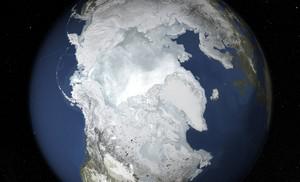Emerging threatsClimate breaks multiple records in 2016, with global impacts
The year 2016 made history, with a record global temperature, exceptionally low sea ice, and unabated sea level rise, and ocean heat, according to the World Meteorological Organization (WMO). Extreme weather and climate conditions have continued into 2017. WMO Secretary-General Petteri Taalas said that the increased power of computing tools and the availability of long term climate data have made it possible today, through attribution studies, to demonstrate clearly the existence of links between man-made climate change and many cases of high impact extreme events in particular heatwaves.

Sea ice covering the Arctic Ocean during the winter peak in February 2015 // Source: theconversation.com
The year 2016 made history, with a record global temperature, exceptionally low sea ice, and unabated sea level rise and ocean heat, according to the World Meteorological Organization (WMO). Extreme weather and climate conditions have continued into 2017. The WMO says that itissued its annual statement on the State of the Global Climate ahead of World Meteorological Day on 23 March. It is based on multiple international datasets maintained independently by global climate analysis centers and information submitted by dozens of WMO Members National Meteorological and Hydrological Services and Research Institutes and is an authoritative source of reference. Because the social and economic impacts of climate change have become so important, WMO partnered with other United Nations organizations for the first time this year to include information on these impacts.
“This report confirms that the year 2016 was the warmest on record – a remarkable 1.1 °C above the pre-industrial period, which is 0.06 °C above the previous record set in 2015. This increase in global temperature is consistent with other changes occurring in the climate system,” said WMO Secretary-General Petteri Taalas.
“Globally averaged sea surface temperatures were also the warmest on record, global sea levels continued to rise, and Arctic sea-ice extent was well below average for most of the year,” he said.
“With levels of carbon dioxide in the atmosphere consistently breaking new records, the influence of human activities on the climate system has become more and more evident,” said Taalas.
The increased power of computing tools and the availability of long term climate data have made it possible today, through attribution studies, to demonstrate clearly the existence of links between man-made climate change and many cases of high impact extreme events in particular heatwaves, he said.
Each of the sixteen years since 2001 has been at least 0.4 °C above the long-term average for the 1961-1990 base period, used by WMO as a reference for climate change monitoring. Global temperatures continue to be consistent with a warming trend of 0.1 °C to 0.2 °C per decade, according to the WMO report.
The powerful 2015-2016 El Niño event boosted warming in 2016, on top of long-term climate change caused by greenhouse gas emissions. Temperatures in strong El Niño years, such as 1973, 1983 and 1998, are typically 0.1 °C to 0.2 °C warmer than background levels, and 2016’s temperatures are consistent with that pattern.
